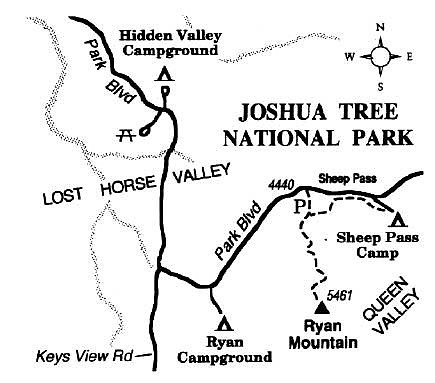 Facebook
Facebook
 X
X
 Instagram
Instagram
 TikTok
TikTok
 Youtube
Youtube
Elongated Ryan Mountain rises above the boulder-studded plains of Lost Horse and Queen Valleys in Joshua Tree National Monument. The view from the top is arguably the best in the national park, encompassing the blocky summits of San Jacinto and San Gorgonio, the intricately dissected Wonderland of Rocks, and a succession of shimmering basins and skeletal mountain ranges stretching east toward the Colorado River and south toward Baja California. The 1.5-mile trail from the mountain's base to its top is well worn, yet steep and rocky enough to be a hazard for young children (and others) prone to tripping or stumbling.

Your hike begins at the Ryan Mountain parking area, on Park Boulevard one mile west of the entrance to Sheep Pass Group Camp. Starting from the town of Joshua Tree, you can drive 17 miles southeast on Park Boulevard to reach this point.
The trail takes you straightforwardly uphill along the north and west flanks of the mountain, amid scattered juniper and pinyon pine. Very soon, the geologic character of the rock underfoot changes. You cross the boundary between the White Tank monzogranite, the same rock you see exposed in boulder piles in the valleys below, and the Pinto gneiss, a much older rock into which the monzogranite rock was intruded some 130 million years ago. The Pinto gneiss, which is foliated with layers of dark minerals, was metamorphosed (changed by heat and pressure) around 1.5 billion years ago, during an era when life on Earth consisted of nothing more than one-celled organisms.
If you can swing it, try a morning-twilight ascent of Ryan Mountain in the late fall or early winter. As the sun rises, look down and watch the interplay of light and shadow across the Joshua-tree dotted plains and on the monzogranite boulder piles, which rise like battlements out of the alluvium.

Elongated Ryan Mountain rises above the boulder-studded plains of Lost Horse and Queen Valleys in Joshua Tree National Monument. The view from the top is arguably the best in the national park, encompassing the blocky summits of San Jacinto and San Gorgonio, the intricately dissected Wonderland of Rocks, and a succession of shimmering basins and skeletal mountain ranges stretching east toward the Colorado River and south toward Baja California. The 1.5-mile trail from the mountain's base to its top is well worn, yet steep and rocky enough to be a hazard for young children (and others) prone to tripping or stumbling.

Your hike begins at the Ryan Mountain parking area, on Park Boulevard one mile west of the entrance to Sheep Pass Group Camp. Starting from the town of Joshua Tree, you can drive 17 miles southeast on Park Boulevard to reach this point.
The trail takes you straightforwardly uphill along the north and west flanks of the mountain, amid scattered juniper and pinyon pine. Very soon, the geologic character of the rock underfoot changes. You cross the boundary between the White Tank monzogranite, the same rock you see exposed in boulder piles in the valleys below, and the Pinto gneiss, a much older rock into which the monzogranite rock was intruded some 130 million years ago. The Pinto gneiss, which is foliated with layers of dark minerals, was metamorphosed (changed by heat and pressure) around 1.5 billion years ago, during an era when life on Earth consisted of nothing more than one-celled organisms.
If you can swing it, try a morning-twilight ascent of Ryan Mountain in the late fall or early winter. As the sun rises, look down and watch the interplay of light and shadow across the Joshua-tree dotted plains and on the monzogranite boulder piles, which rise like battlements out of the alluvium.
Comments